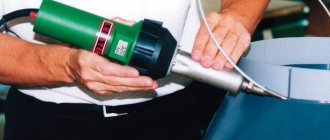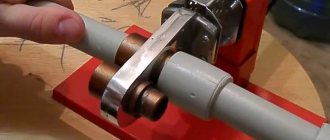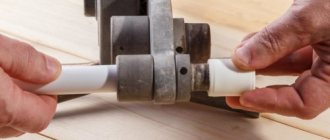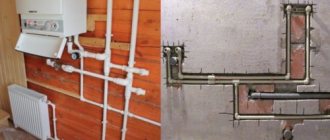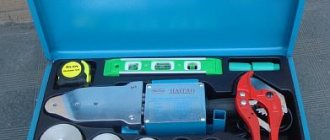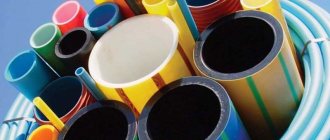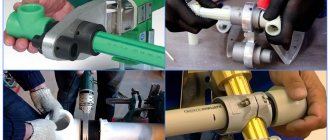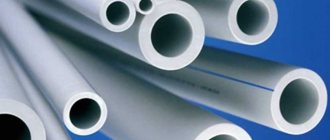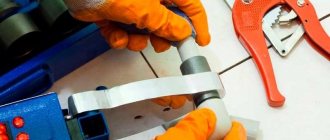Pipes made from artificial polymers such as PVC have become extremely popular due to their low price and ease of installation. For this reason, over time they began to replace classic metal pipes, this is especially noticeable when designing or repairing plumbing systems in apartments and houses. Old rusty pipes are simply replaced with new plastic ones, and this is done in a couple of hours.
But the merit of the quick installation of such pipes does not lie in the skill of the welder. After all, a special soldering iron is used for welding PVC pipes. A soldering iron for PVC pipes can be purchased in a store, and there are quite budget models that won’t break your pocket. But what if you are not ready to purchase a new device and want to save money, or just like to make electrical appliances with your own hands? In this case, you can make a soldering iron yourself, and we will explain in detail how to do this in this article.
general information
A machine for welding PVC products (or pipes made of any other artificial polymers) is an electrical device operating from a standard 220V network, designed for soldering pipes of various diameters.
Before we begin assembling this device, it would be nice to know what it consists of. The key elements of any soldering iron for pipes are a body with a comfortable handle, a thermostat, which sets the required heating temperature for the heating element, and the heating element itself, hidden in a metal casing that heats up.
Additionally, the kit can be supplied with nozzles for soldering pipes of different diameters. We have dedicated a separate article to the topic of attachments; read it to be aware of all the features. Here we will say one thing: it is preferable to use Teflon-coated nozzles. This way they are guaranteed not to stick to the pipes during heating.
Surely you may have heard that such soldering irons are often called “irons”. And this is not without reason. The fact is that the heating element is indeed visually very similar to the soleplate of an iron and their operating principle has much in common. In both the iron and the soldering iron, the surface is evenly heated, only in the case of a soldering iron, the heat from the heating element is transferred to the nozzles, and the pipe is then pressed against them to melt its edge.
In this case, the heating temperature is set using a thermostat installed in the soldering iron body. Adjusting the temperature is extremely important, because if it is too high, the pipe will simply melt in the nozzle, and if it is too low, it will simply not be able to warm up evenly. This means that the connection will be of poor quality and will quickly leak if we are talking about installing a water supply system, for example.
Secrets of soldering auto plastic
Many motorcyclists and motorists have to deal with the fact that the plastic parts of their vehicles (most often bumpers) receive some damage and lose their former appearance.
But instead of buying a new spare part, you can restore the old one yourself by soldering. Soldering plastic is not that difficult.
Necessary tool
In this case, the following soldering tools can be used:
- an ordinary 100-watt soldering iron;
- hair dryer (also called a heat gun);
- Soldering Station.
The capabilities and operating principle of a conventional soldering iron are familiar to almost every home craftsman. Such a soldering apparatus may have a straight or curved tip.
The hot-melt gun solders plastic by supplying heated air. The heating temperature ranges from +80 to +600 ℃, it can be continuously adjusted.
As a rule, models of soldering guns are equipped with a large number of attachments that make this tool as convenient and efficient as possible.
The nozzles help direct the air to the desired area and create the required angle of inclination. High-quality hair dryers for soldering plastic have a power of at least 1600 watts.
The soldering station combines a regular soldering iron and a hot-melt gun for plastic. Such a unit is capable of solving many problems. Temperature adjustment and a huge number of attachments allow you to carefully solder plastic, as well as other materials.
Types of plastics
In order to successfully repair a car element, it is worth determining in advance what kind of plastic it is made of. All plastics can be divided into hard and soft. In particular, fiberglass plastics that do not have any markings are considered soft.
Hard types of plastics can have different markings, for example, ABS, GF30, PAG6. The markings are visible if you look from the back of the vehicle part. Polypropylene (PP marking) is considered the most durable.
Quite often, vehicle owners require soldering of ABS plastic, since it is from this material that the bumpers of cars of many well-known brands are made.
Use of a soldering iron
Let's assume that the plastic bumper of a car is seriously damaged and needs to be repaired by soldering. How to do it?
To make it easier to solder the structure, it must be removed from the car. It also doesn’t hurt to look at the labeling in advance. Most likely, the part will be made of ABS plastic.
Then you should clean the surface of the bumper from dirt, remove paint and varnish residues. Additionally, the entire plastic part must be degreased. Next, you need to connect all the fragments of the bumper together.
For such a connection, it is important to use clamps or staples. But this must be done carefully so that they do not penetrate through the car plastic.
Soldering plastic with a standard soldering iron should begin from the inside of the car bumper . To do this, one of its edges is securely fixed, and special plastic electrodes are laid along the future seam (although the name “electrodes” in this case is very arbitrary).
At the next stage, a soldering iron for soldering plastic melts the electrode material, and it fills all the recesses of the crack. This operation must be repeated as many times as stitches need to be made, that is, it all depends on the initial number of defects and damage.
Now you need to wait for the molten mass (characteristic bubbles appear on it) to cool a little - this will take about five minutes. Then you need to smooth out the seams on the plastic.
In principle, any blunt object can be used for this procedure. In hard-to-reach places, the surface can be smoothed and leveled with gloved hands. Complete hardening of the seams will occur in a few hours. At this point, the soldering of the auto plastic can be considered complete.
Using a hair dryer
Soldering automotive plastic is done a little differently if a heat gun (hair dryer) is used. Here you will need special welding rods (essentially, this is solder for soldering plastic).
You can purchase them in specialized stores or even make them yourself. The main thing is that they are similar to the material being welded. One of the ends of the rod is sharpened and then inserted into the corresponding hole in the nozzle of the heat gun.
The hair dryer should be moved slowly along the crack being repaired; the filler rod should be inclined towards the workpiece at an angle of approximately 45°. If a plastic part has shattered into separate pieces, then soldering it with a hairdryer is carried out in two passes.
First, the pieces or fragments are fastened together with short stitches (seams). And only after this the final reliable soldering is made. When the material has cooled, the surface of the part is puttied and sanded, preparing for painting.
To repair the plastic of a motorcycle, all kinds of elements of its external design, you can use soldering using approximately the same technology as in the case of repairing a car bumper. Moreover, motorcycle panels are usually made of the same ABS plastic.
Reinforcing mesh
Also, home craftsmen can use in their work such a device as a reinforcing mesh for soldering hard plastic.
Peculiarities
Unfortunately, budget soldering irons are not always equipped with thermostats, and this is a big minus. After all, it is difficult for beginners to determine when the temperature is insufficient or excessive. In addition, not all home craftsmen will use the purchased soldering iron often. And spending a couple of thousand rubles on a device that will gather dust on a shelf for years is not the most rational decision.
Read also: Rating of the best soldering irons for polypropylene pipes
There is also another drawback of budget soldering irons - their unsatisfactory workmanship and sometimes poor-quality finished seam. So why buy a low-quality item and then use it a couple of times and throw it into the far corner? It is better to make a soldering iron with your own hands from improvised materials and a couple of resistors.
Of course, a homemade tool won't be as good as a $200 soldering iron, but it will definitely help you with one-time minor repairs. In addition, you yourself will know what it is made of and will be able to choose better materials. Instead of cheap plastic (which can be found in all Chinese soldering irons), take aluminum. Then your device will be head and shoulders above budget store-bought soldering irons. It is enough to apply minimal knowledge of electrical engineering.
Thermal fuse
And one of the interesting things there is a thermal fuse! This could be the reason for the underheating. It is located under the protective grille, bolted to the heater.
Its function is Additional protection. Although all control - heating, monitoring, turning off and turning on - is taken over by the electronics, the manufacturers have installed additional protection. In case, for example, the thyristor breaks down and the heating element stops being controlled by the controller.
How it works and why it broke
In the event of a breakdown of the electronics, when a certain temperature is reached, the bimetallic contacts of the fuse will open and turn off the heating element, preventing it from overheating. The principle of operation is like an iron, if anyone is familiar with it, they understand what I mean.
A more detailed check showed that this was so, my instinct did not let me down. The reason for this malfunction is as follows. A fairly decent current flows through the closed contacts of this fuse. Under current load, over time, the contacts begin to heat up, then slowly burn - stronger and stronger, and eventually their ability to conduct current becomes worse.
As a result, the amount of energy sufficient for normal heating is not transferred to the heating element. Part of it is lost on these burnt contacts, which makes them heat up even more.
Do you remember what happens when the thermal fuse heats up? As it heats up, its contacts tend to open. All this only further worsens the contact in this circuit or breaks it altogether.
Thermal fuse
Soldering iron assembly
soldering iron for plastic pipes
Let's start assembling. To weld polypropylene pipes we need an old iron. We need to remove the “sole” from it, it will act as a heating element. In the photo it is shown as number 1. We drill a hole in the heating element and use bolts to attach the heating elements on both sides. Next, you need to make a thermostat (number 3 in the photo) and pack it in a heat-insulating casing, it is indicated by number 2.
To assemble the thermostat, use the diagram below. For R1 you will need a variable resistor of 500 kOhm, for R2 - a resistor of 4.7 kOhm 0.5, for R3 - you can take a resistor of 1 mOhm, 0.25 w. For VS1, DB-3 type dinistors are perfect; for VS2, take TC 25-4 triacs. An electric heater with a power of 1000V is suitable for T3H. And for C1 we recommend taking a 0.1 uF capacitor, 400 v. Use a neon lamp type HL 1 as an indicator light.
Prepare the aluminum housing. In our case, the size is 13x6x9 centimeters. Place the thermostat on the board in it; the board should be made of foil PCB. Place the temperature control knob outside the aluminum housing. It is desirable that it has divisions. Additionally, you can equip the device with a light bulb for convenient indication. It will signal that the device is turned on and heating up.
Fix all this on a PCB plate (number 4). Then attach it to the heating element and place it on an aluminum stand (number 5). Be sure to place a fluoroplastic insulator between the plate and the casing (number 6 in the photo).
Insert the protruding part of the PCB plate into the groove (its location is indicated by number 8 in the photo). It can be removed at any time for more convenient storage. You can also build a handle out of wood and attach it to the plate. All! The iron for PVC pipes is ready.
This device can be used in the same way as a factory-made soldering iron. Using such a device, we soldered pipes with a diameter of 20 millimeters and heated them for only 3-5 seconds. The heating element generates so much heat that it is enough for quick and high-quality soldering.
Materials and tools
But there is an old “bucket” soldering iron, which I have not needed for a long time. So I decided to make something out of it.
I needed a few more details.
- aluminum wire and plate;
- textolite sheet;
- thermostat and iron indicator lamp;
- ceramic insulators;
- thermal paste;
- thermal tape;
- nozzle for welding polypropylene pipes (25mm);
- new electrical plug;
- various bolts and nuts.
Variety of models
Product 'Ermak'
There are two types of soldering machines on sale. The first type is equipped with a flat tip. In the second type of device, the soldering element is made in the shape of a cylinder. Each variety has its own characteristics. According to many experts, models with a cylinder-shaped sting are more convenient. Since the soldering element is compact in size, the device can be used even in small spaces.
Each type of device is equipped with its own type of replaceable attachments. For models with a flat tip, the nozzle is installed using a special bolt. The plate has several holes for connecting two or three nozzles.
For models with a cylindrical tip, the heating elements look like clamps. They crimp the cylinder and are secured with several bolts. The replaceable nozzles of the second type of device (unlike the first) do not scroll relative to their axis. This greatly simplifies the soldering process. Because there is no need to tighten the bolts.
You also need to pay attention to the configuration of the nozzles. Most often, a set contains at least three attachments. Some models are equipped with six replaceable heating elements to work with structures of different sections.
Today, the most popular manufacturers of soldering irons for polypropylene structures are the following brands:
- Ermak;
- Storm;
- Quick;
- Wavin ekoplastik;
- Kraftool;
- Lava;
- Neo.
To choose a tool you need to know which one is better. To do this, just read consumer reviews. Note that it is better to spend a little more money and purchase a quality tool from a well-known brand than to purchase a cheap Chinese device.
Also pay attention to the power of the equipment. As a rule, for devices this figure can be from 800 to 1500 W. Such devices are used for soldering structures with cross-sectional sizes of 15, 20, 32 and 50 millimeters. If we are talking about joining products with a diameter of up to 63 millimeters, it is better to use equipment with a power of 1700 watts or more. There are also models designed for soldering products with a cross-section of 75, 90 or 110 millimeters.
Typically, the equipment package includes a standard set of additional elements.
As a rule, the list contains:
- replaceable nozzles;
- bolts;
- shipping container;
- stand;
- thermal gloves;
- roulette;
- level;
- instructions.
Try to choose a tool that is as complete as possible with everything you need. This will allow you to save money and time. Equipment from well-known manufacturers in most cases comes with all the necessary additional elements. Often soldering irons can be equipped with scissors for cutting pipes.
How to fix it?
Which exit? Trying to restore a thermal fuse is a thankless and useless task. Even if this works, it will not last long and soon you will have to disassemble the soldering iron again for repeated repairs.
Replace with a new one? This is ideal! But where can I get one like that? Therefore, the method remains reliable, but radical. Remove him from the chain!
The task is the following. You need to disconnect the fuse terminal (black wire in the photo) from the heating element contact.
Disconnect the terminal
You can, of course, bite off the fuse and connect the blue black wire to the existing terminal, but this is not the best option, since the connection will begin to heat up over time and also needs to be insulated.
But ordinary electrical tape is not suitable for this, because there is strong, natural heating from the heating element, it will melt.
It’s best to crimp a new terminal onto the blue wire; it costs pennies at an electrical goods store. I had the terminals insulated, but I decided to remove it because I’m not sure that it will withstand the temperature. It is better to use the heat-resistant casings that were on the wires.
New terminal
We prepare the wire and crimp the terminal on it; if there are no special pliers for this, this can be done with pliers, the crimping must be reliable, the wire should not dangle in the terminal.
Preparing the wire and terminal for crimping The wire is ready for connection. The wires are connected and ready to be assembled.
Well, the electrical part is ready, all that remains is to put everything together and check it.
Bonding technology
Repair consists of several mandatory steps that cannot be skipped or swapped.
- Removing the bumper. If the plastic cover is cracked in several places, before removing it, you need to secure it with tape from the outside (so that the part does not fall apart).
- Preparatory work includes choosing an adhesive composition, selecting tools, cleaning the bumper, and preparing the surface. All work is carried out in a warm, well-ventilated area.
- Gluing process.
- Grinding.
- Painting.
Glued bumper
If it is necessary to repair a small crack, chip or deep scratch, after preparing the bumper, glue is applied from the outside, filling the gap with the composition, and lightly pressing the plastic. If the crack is significant and crosses the edge of the lining, use epoxy glue and fiberglass.
Preparation
Preparing the bumper before gluing it with epoxy glue and fiberglass in steps (if there is a significant crack):
- Wash the bumper and dry it.
- Sand the damaged area with coarse sandpaper, this will increase adhesion, and degrease with white spirit.
- Correct the fracture site.
Coat all cracks on the outside with hot glue (use a gun) or plasticine. This will prevent the epoxy from leaking out during drying and seal the future seam. Seal the outside with tape over hot glue. This will additionally maintain the shape of the bumper during the repair process.
Materials and tools
If there is a large gap, the bumper on the car must be sealed with two-part epoxy glue, which is diluted before the main work. The assorted two-component compounds “Khimkontakt-Epoxy” and the one-component “Nowax STEEL EPOXY ADHESIVE (steel 30 g)” earned good reviews from drivers.
What you will need for work:
- epoxy - 300 g;
- fiberglass - 2 m;
- brush;
- automotive primer, degreaser, auto enamel;
- sandpaper, scissors.
All work is carried out at a temperature of 18-20 degrees. The epoxy glue hardens for up to 36 hours; during this time, the bumper cannot be turned over and the adhesion strength must be checked. If the adhesion of materials is disrupted, in winter the inside of the glued patch may crack.
Repair process
Measure the required amount of fiberglass to cover the entire fracture area and cut it off. Craftsmen recommend using fiberglass rather than fiberglass to glue the bumper to the car. The material will increase the density of the seam and its strength.
Dilute epoxy glue if using a two-component composition. Take 10-12 parts of resin, 1 part of hardener, mix thoroughly. Leave for 5 minutes in a warm place (20-23 degrees).
Repair process step by step:
- Coat the inside of the body kit generously with glue.
- Apply fiberglass fabric, press it to the bumper, soak it with glue, make sure that no air remains.
- Apply glue and glue the fabric in 2-3 layers.
- Apply the last layer of glue.
- Place the bumper in a warm place for 24 hours, preferably in such a way as to reduce the stress on the crack, but not on its side, since the resin will drain as it hardens.
Bumper painting after repair
The final stage is putty and painting. After the glue has dried on the outside of the bumper, the bumper is sanded and primer is applied, and after drying it is painted.
